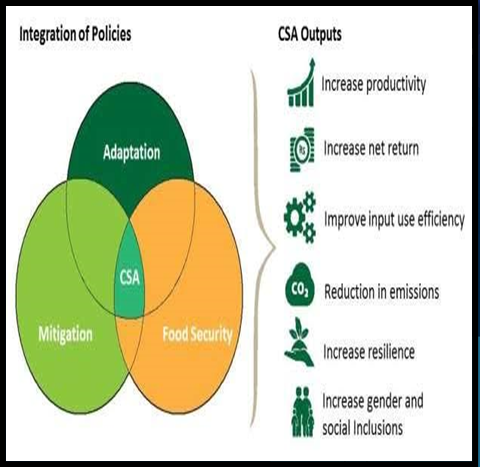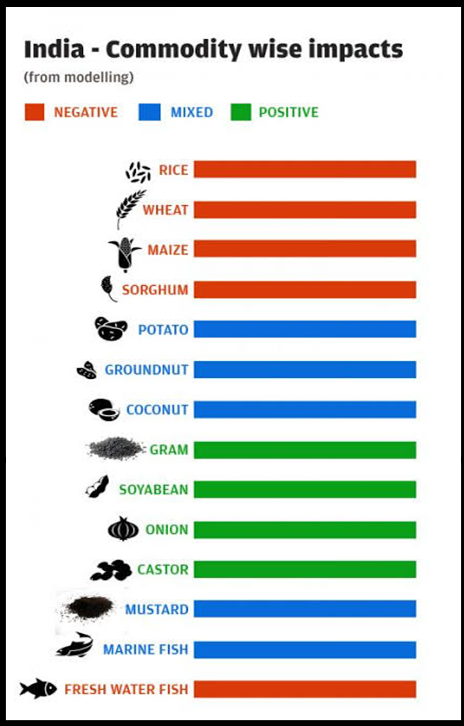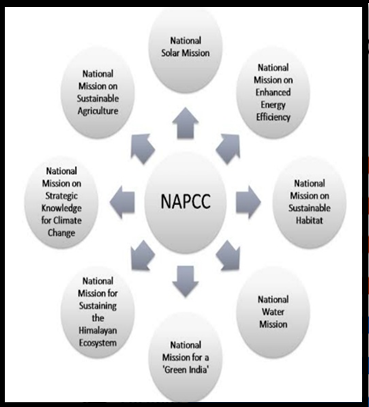NEED FOR CLIMATE-SMART AGRICULTURE IN INDIA
Relevance
- GS 3: Climate change and issues related to climate change, E-technology in the aid of farmers.
Cropping Patterns in various parts of the country, Issues and Related Constraints.
Source: Research Gate
As climate change intensifies, its profound impact on agriculture becomes increasingly apparent. Escalating temperatures, erratic weather patterns, and extreme events disrupt the delicate balance between climate and crops.
Climate Change and Food Insecurity
- Climate change and food insecurity stand out as the two critical challenges of the 21st century.
- Ongoing climate change effects, including heat waves, floods, droughts, and cyclones, significantly impact lives and livelihoods.
- Southern continents face severe droughts, adversely affecting agricultural production and farmer livelihoods.
- Climate Change exacerbates the existing challenges of population growth and dietary changes.
Climate Change Impact on Agriculture
- Traditional farming practices become less productive due to climate change.
- Climate change increases risks for farmers, necessitating a reevaluation of agricultural practices.
- Farmers adopt adaptation measures to mitigate climate change’s adverse effects.
Climate-smart agriculture (CSA)
- Climate-smart agriculture (CSA) is an approach integrating sustainable practices to address the challenges posed by climate change.
- It aims to enhance agricultural productivity, build resilience to climate-related risks, and reduce greenhouse gas emissions.
- By employing innovative techniques like precision farming and agroforestry, CSA ensures sustainable food production, economic autonomy for farmers, and environmental conservation in the face of changing climatic conditions.
Holistic Strategy: Climate-Smart Agriculture (CSA)
- CSA provides a holistic framework to address the dual challenges of climate change adaptation and mitigation.
- CSA encompasses three objectives:
The Food and Agriculture Organization (FAO) defines CSA with three pillars;
| 1. | Sustainably increasing agricultural productivity and incomes |
| 2. | Adapting and building resilience to climate change |
| 3. | Reducing greenhouse gas emissions. |
- CSA practices include
- Water-smart, Weather-smart, energy-smart, and carbon-smart practices,
- Enhancing productivity,
- Addressing land degradation, and
- Improving soil health.
Challenges in Agricultural Productivity
- Future climate change impacts could lead to substantial declines in agricultural productivity.
- In India, crop yield decline due to climate change is projected to be as high as 9% between 2010 and 2039.
- Radical reforms are required in the agricultural industry to combat climate change and sustainably boost output.
Source: Down to Earth
Sustainable Development Goals and National Action Plan
- United Nations’ Sustainable Development Goals aim to end hunger and enhance environmental management, aligning with CSA goals.
- The National Action Plan on Climate Change ( NAPCC) emphasizes climate-resilient agriculture in India’s adaptation measures.
- Initiatives like the Soil Health Card Scheme focus on optimizing agricultural methods.
| SDG 2: End hunger
· This goal aims to end hunger, ensure access to nutritious food, and promote sustainable agriculture practices by 2030. · It includes targets related to doubling agricultural productivity, enhancing sustainable production systems, strengthening resilience to climate change, and promoting sustainable food consumption patterns. National Action Plan on Climate Change (NAPCC) · The National Action Plan on Climate Change (NAPCC) is a government of India’s programme launched in 2008 · It aims to mitigate and adapt to the adverse impact of climate change. · The plan outlines eight national missions on climate change, which focus on various sectors such as solar energy, energy efficiency, habitat, water, Himalayas, green India, sustainable agriculture, and strategic knowledge for climate change.
Soil Health Card · The Soil Health Card (SHC) Scheme operates under the Ministry of Agriculture and Farmers’ Welfare. · According to the National Productivity Council (NPC), the scheme has reduced chemical fertilizer use by 8-10% and boosted productivity by 5-6%. · Encompassing the entire country, the scheme provides farmers with a soil health card every three years. · The detailed report, presented in the form of a card, offers comprehensive information about the soil on their specific farm. · Utilizing GPS tools and revenue maps, soil samples are collected in a grid of 2.5 ha in irrigated areas and 10 ha in rain-fed regions. |
Community-Supported Agriculture Efforts
- Community-supported agriculture efforts globally aim to create resilient and environmentally friendly agricultural systems.
- CSA promotes agroforestry, sustainable water management, and precision agriculture to address climate change disruptions.
Benefits of CSA Implementation
- CSA increases resilience to climate-related dangers and shocks.
- Economic autonomy of farmers improves as CSA distributes information and provides access to climate-resilient methods.
- CSA helps disadvantaged farmers adapt to changing climates, fostering economic and social transformation.
CSA’s Role in Reducing GHG Emissions
- Agriculture contributes significantly to greenhouse gas emissions (17% in 2018).
- CSA implementation is crucial for lowering GHG emissions and enhancing farmland carbon storage.
- CSA aligns with the Paris Agreement goals to limit global warming.
Flexible Concept with Localized Responses
- CSA is a flexible concept with various potential applications, emphasizing local responses to global warming.
- Investment in capacity-building programs and providing practical CSA tools and knowledge is essential.
Government Initiatives in India
- National Mission for Sustainable Agriculture (NMSA):Focuses on water use efficiency, soil health management, and enhancing farm resilience.
- Paramparagat Krishi Vikas Yojana (PKVY): Encourages organic farming practices to reduce chemical usage and environmental impact.
- National Initiative on Climate Resilient Agriculture (NICRA): Develops climate-resilient farming technologies.
- Biotech-Krishi Innovation Science Application Network (Biotech-KISAN): Utilizes biotechnology for sustainable and climate-smart agriculture.
- Climate Smart Village (CSV):Implements climate-smart agriculture in specific villages.
- Public and private sector entities, including farmer-producer organizations and NGOs, contribute to CSA adoption.
Potential Benefits for Indian Farmers
- Majority of Indian farmers are small or marginal; CSA can help increase their profits.
- India stands at a unique juncture where CSA adoption is not only desirable but essential.
CSA for a Sustainable Future
- CSA has the potential to assure food security, empower farmers, and protect ecosystems.
- Innovation, resilience, and sustainability merge in CSA to provide inspiration for a sustainable future in the face of climate change.
Climate-Smart Agriculture (CSA) stands as a transformative force in India’s agricultural realm, addressing climate change impacts comprehensively. CSA not only ensures food security and economic autonomy but also fosters resilience and innovation for a balanced future.
Mains Practice Question:
Climate Change exacerbates the existing challenge of Food Security. Discuss the potential benefits and challenges associated with the implementation of Climate Smart Agriculture (CSA) in the Indian context.

 Source: Research Gate
Source: Research Gate Source: Down to Earth
Source: Down to Earth Source: Green Clean Guide
Source: Green Clean Guide

